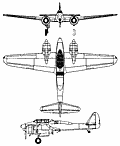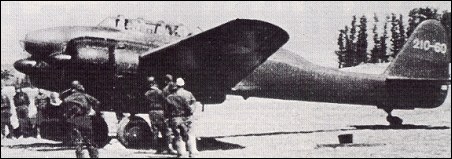|
| Just as specialist night-fighter design
had largely been ignored by European
nations before World War II,
Japan's similar failing left the country
without adequate night defence when
the fortunes of war began their inexorable
turn against her in 1943. Fortunately,
however, the Imperial
Japanese Navy possessed a number of
excellent heavy fighters and reconnaissance
aircraft, of which the Nakajima
J1N Gekko (moonlight) had been
arriving in service slowly since April
1942 with reconnaissance units in the
Western Pacific. When first encountered
in action during the Solomons
campaign the aircraft was mistakenly
thought to be a fighter and codenamed
'Irving' by the Allies. As night air
attacks were stepped up by the Americans
it was the commanding officer of
the 251st Kokutai, Commander Yasuna
Kozono, then based at Rabaul, New
Guinea, who first suggested adaptation
of the J1N as a night-fighter by installing
two 20mm cannon in the observer's
cockpit, fixed to fire obliquely
forward and upward at an angle of 30�,
and another pair firing forward and
downward. When two Consolidated
B-24s were quickly destroyed, the
modifications came to the attention of
the Japanese naval staff and an order
was placed with Nakajima to go ahead
with a dedicated night-fighter version,
designed and built as such from
scratch. This version, the J1N1-S, entered
production in August 1943 and
continued until December 1944, during
which period a total of 420 J1Ns
were produced, the great majority of
them J1N1-S night-fighters. These differed
from the earlier reconnaissance
version in having the crew reduced
from three to two, the observer's cockpit
being eliminated and faired over;
all aircraft retained the upward-firing
cannon, but the downward firing guns
(found difficult to aim and seldom
used) were omitted from later aircraft,
while a third upper gun and a forward-firing
20mm cannon was fitted in the
J1N1-Sa. Rudimentary centimetric AI
radar was installed in the nose and
some airciaft also carried a small nose
searchlight. In service with the 251st,
302nd and 322nd Kokutais, the J1N1-S
night-fighters proved fairly effective
against the B-24, which was not in any
case well-suited to night operations,
but with the appearance of the Boeing
B-29 the Japanese night-fighters
proved too slow and were seldom able
to make more than a single firing
attack. Most of them were expended
during the final months of the war
when, equipped to carry two 250kg bombs, they were employed
in kamikaze attacks against ground
targets.

| MODEL | J1N1-S |
| CREW | 2 |
| ENGINE | 2 x Nakajima "Sakae-21", 843kW |
| WEIGHTS |
| Take-off weight | 8185 kg | 18045 lb |
| Empty weight | 4850 kg | 10692 lb |
| DIMENSIONS |
| Wingspan | 16.98 m | 56 ft 9 in |
| Length | 12.77 m | 42 ft 11 in |
| Height | 3.99 m | 13 ft 1 in |
| Wing area | 40 m2 | 430.56 sq ft |
| PERFORMANCE |
| Max. speed | 507 km/h | 315 mph |
| Ceiling | 9320 m | 30600 ft |
| Range w/max.fuel | 3780 km | 2349 miles |
| ARMAMENT | 4 x 20mm cannons |
 | A three-view drawing (752 x 912) |
| ubaTaeCJ, e-mail, 21.02.2025 16:53 20 reply | | wudao, 20.06.2011 06:26 What were the production figures for all forms (recon, night fighter and heavy fighter) of this aircraft type reply | | bombardier, e-mail, 24.05.2011 19:06 Looks like a Bf-110 reply | | Terry, e-mail, 12.02.2011 07:25 You can see a J1N Gekko / Irving at the National Air & Space Museum Udvar Hazy Center, located just south of Dulles International Airport. It has been restored and is a fine display aircraft. It may be the sole surviving example, but I'm not sure. reply | |
| | Randy, e-mail, 30.12.2010 05:35 What were the production figures for all forms (recon, night fighter and heavy fighter) of this aircraft type? reply | | Jackie, 08.08.2010 05:51 The J1N Gekko was not really a significant aircraft. Because of its twin engine, it was not maneuverable like other fighters. However, its cannons were deadly against bombers, making it a deadly bomber destroyer until the high flying B-29 Superfortress appeared. It was also used as kamikaze aircraft reply | | Richard Franson, e-mail, 10.11.2008 06:47 One of these brought down my dad's B-29 over Kyushu Island Japan on April 18th 1945. During a bombing strike against enemy airfields and air battle a plane of this type was hit by machine gun fire from another B-29. Badly damaged the enemy aircraft swept across the formation and collided with my dad's plane. reply |
|
Do you have any comments?
|
| 
COMPANY
PROFILE
All the World's Rotorcraft
|








